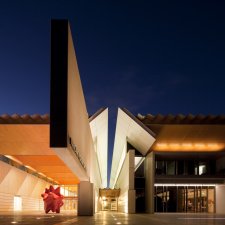- About us
- Support the Gallery
- Venue hire
- Publications
- Research library
- Organisation chart
- Employment
- Contact us
- Make a booking
- Onsite programs
- Online programs
- School visit information
- Learning resources
- Little Darlings
- Professional learning
Arnold Shore, a lifelong inhabitant of Melbourne, was apprenticed to a stained glass and leadlight company called Brooks, Robinson soon after leaving school at the age of twelve. He worked there for more than twenty years, and there, he met his lifelong friend, artist Jock Frater. For five years before World War 1 he trained at the NGV School under Frederick McCubbin, but left before completing his qualifications, transferring to the tuition of Max Meldrum until 1923. Meanwhile, he read up on modern European art when he got the chance. Over the 1930s he developed a reputation for flower studies before turning to the bush, which became a favourite subject. He exhibited with the Twenty Melbourne Painters’ Society, a breakaway group from the dominant Victorian Artists’ Society, from 1923 to 1946. In 1932, with the older and wealthier George Bell, an established art critic, he founded the Bell-Shore School. Bell had been classically trained; as Shore put it, ‘Bell’s training and experience was balanced by my enthusiasm and sense of art . . . He generally trusted to logic. I depended on feeling.’ The school quickly became an important influence on the development of Melbourne modernism but tensions developed between the founders and the partnership dissolved in 1936. In 1935 HV ‘Doc’ Evatt and his wife Mary Alice gave Shore his first portrait commission (amongst the first works acquired for the collection of the National Portrait Gallery in 1998). The National Gallery of Victoria first purchased one of Shore’s works in 1937, and for some years he gave annual lectures there about modern art. From that time, his works were purchased by state galleries in Brisbane, Adelaide and Sydney, and he also found himself increasingly teaching, lecturing, critical reviewing and judging art prizes. He won the Crouch prize in 1938. Shore’s career was at its high through much of the 1940s, when he lived at Mount Macedon and painted rich and distinctive views of the bush. By the spring of 1949 he had had six solo shows in Melbourne, the National Gallery of Victoria had five of his works and the Art Gallery of Western Australia had bought one of his paintings. In the 1950s, however, he painted very little. Throughout his life the artist endured periods of suicidal depression and anxiety, which were addressed with shock treatment and the prototype medications of the day. Shore was art critic for the Argus and the Age. In 1957, Tam and Anne Purves held the first major retrospective of his works – nearly a hundred of them - at their new Australian Galleries; both Alan McCullough and John Brack declared his significance. In 1960 and 1961 he was president of the Victorian Artists’ Society, which awarded him its medal of honour. In 1962 he was one of six Australian painters represented in a touring exhibition through Victoria, curated by James Mollison for the National Gallery of Victoria. However, by that time, the Angry Penguins were the fashionable artists of the day. Estranged from his wife and having to sell assets to afford a home, he plunged into melancholy that waxed and waned until he died of natural causes in the autumn of 1963. Shore is represented in all major Australian galleries. Much of this information is taken from Arnold Shore: Pioneer Modernist by Rob Haysom.
Collection: National Portrait Gallery
Gift of Malcolm Shore 2017
Donated through the Australian Government's Cultural Gifts Program
Arnold Shore (age 65 in 1962)
Malcolm Shore (1 portrait)



On one level The Companion talks about the most famous and frontline Australians, but on another it tells us about ourselves.



Visit us, learn with us, support us or work with us! Here’s a range of information about planning your visit, our history and more!



We depend on your support to keep creating our programs, exhibitions, publications and building the amazing portrait collection!